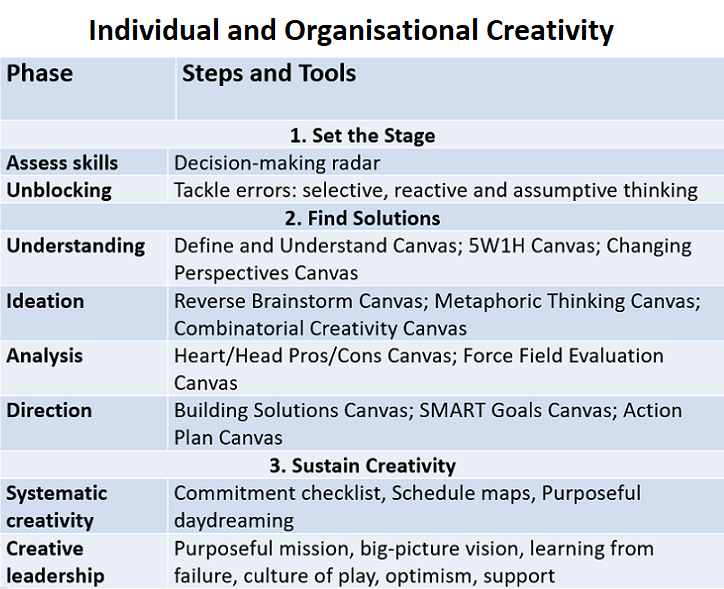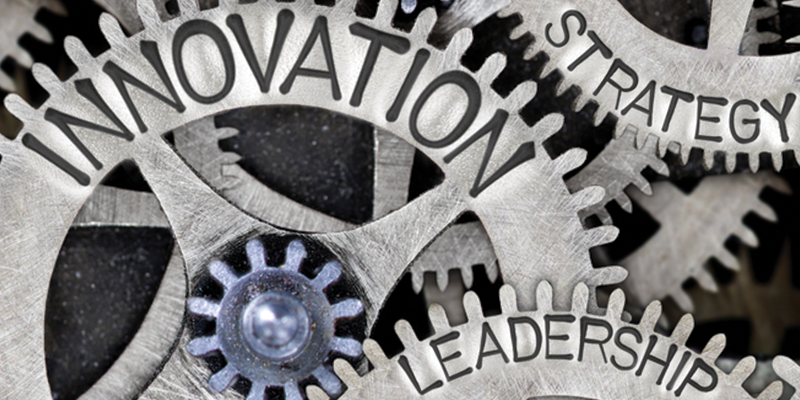Launched in 2012, YourStory's Book Review section features over 280 titles on creativity, innovation, entrepreneurship, and digital transformation. See also our related columns The Turning Point, Techie Tuesdays, and Storybites.
A wealth of tips, frameworks and examples on individual creativity and organisational innovation is featured in the compelling book, The Creative Thinking Handbook: Your Step-by-Step Guide to Problem Solving in Business, by Chris Griffiths and Melina Costi.
More than knowledge, creativity is the new power, the authors begin. “Success is no longer about what we know, but what we can create,” they emphasise.
Chris Griffiths is the Founder and CEO of OpenGenius and co-author of Grasp the Solution and Mind Maps for Business. Melina Costi is co-author of The Positive Leader.
The 12 chapters are thoroughly referenced and written in a manner that would appeal to a wide range of audiences, with lots of checklists and exercises. Readers of the book can sign up online to receive free templates and resources for creative activities.
Here are my key takeaways from this valuable 235-page book, summarised as well in the table below. See also my reviews of the related books Design Your Thinking, The Serendipity Mindset, Creative Confidence, The Creative Mindset, When, Cross-Industry Innovation, Innovator’s DNA, and Business Storytelling Techniques.

Image credit: YourStory
Foundations
The authors define creativity as cultivating and combining ideas, and innovation as creating a better solution or direction. Incremental and disruptive innovations both need to be cultivated by organisations.
Creativity is not about fluffy “airy fairy” activities, and is not restricted only to fields like arts. Creativity, critical thinking, and complex problem-solving are key skills at the individual and organisational levels, Chris and Melina explain.
Rather than thinking outside the box, it’s better to think without the box of biases, assumptions and habits.
Creativity is a continuous journey, and companies which cannot sustain the momentum have fallen by the wayside, as seen in the examples of Blockbuster, Compaq, Blackberry and HMV. On the other hand, innovative products and companies include Nintendo (Switch), Apple (“mobile phone without the keypad”), and Google (moonshot projects).
Successful companies do not depend only on luck or flashes of inspiration – they have systematic principles and processes for innovation. “Like a muscle that’s never exercised, creativity withers through neglect,” the authors caution. “Structure enables creativity to grow,” they add.
Market-driven companies are reactive and focus on incremental innovation of features. In contrast, market-driving companies are agile and focus on disruptive innovation for better value.
The authors do not dwell much on how to build on ideas from customers or co-create with business partners. For these insights, check out my book reviews of Customer Innovation, The Seven Principles of Complete Co-creation, The Startup Owner’s Manual, Design Your Thinking, and Frugal Innovation.
I. Setting the stage
Mental patterns and habits helped deal with routine situations, but creativity requires metacognition for recognising and overcoming practices that inhibit fresh thinking. Chris has developed an online tool called the Decision Radar to assess an individual’s decision-making skills in five categories: understanding, ideation, reasoning, analysis, and direction.
“Thinking about thinking” helps unearth one’s creative blocks. These are of three types: selective thinking, reactive thinking, and assumptive thinking.
Selective thinking leads to confirmation bias and loss aversion in choice of ideas, observations and attention, even in the face of contradictory data. It is important to go beyond the first idea or pet idea, the authors advise. Examples include Henry Ford sticking to only one type of car, leaving the market open for competitors like General Motors.
Reactive thinking is emotional and hasty, but creativity calls for proactive and rational thinking, the author cautions. First-mover approaches or mindlessly copying competitors are not always effective. Unfortunately, information overload and the always-on nature of social media spur more reactive thinking.
Listening only to customers’ current needs will help incremental improvement, but breakthrough innovation depends on foresight and drive of innovators. After all, there is a difference between what consumers say and actually do, the authors observe.
Oreo, Pampers, Google, Facebook, and Apple (iPad) were not the first movers in their respective categories but built on the shortcomings of predecessors. FirstDirect pioneered phone banking even in the face of ridicule, and Facebook continues to plough ahead despite complaints about privacy.
Assumptive thinking relies too much on past beliefs and conventions, even without adequate proof. “Assumptions aren’t hard facts,” the authors emphasise. They lead to intellectual laziness, limited worldviews, self-imposed limits, and even missed opportunities, as seen in many of the creations of Xerox that were never properly commercialised.
Examples of innovators who successfully challenged industry assumptions include Richard Branson (Virgin Atlantic), Japanese automakers (smaller and fuel-efficient cars), and Anita Roddick (Body Shop’s social responsibility commitment).
Unfortunately, many individuals and organisations suffer from negative thinking, with scepticism, binary attitudes, simplistic labels, and paranoia. Typical “dinosaur speak” in stifling organisations includes phrases like quit dreaming, don’t rock the boat, top management won’t buy it, we don’t have the time, or our business is different.

II. Finding solutions
Creative problem solving involves divergent and convergent thinking. The phase of generative, imaginative, and playful ideation needs to be followed by rational, logical and focused reasoning.
1. Understanding
Solving problems begins with properly understanding, framing and articulating what is needed. Questions like It would be great if or How might we help trigger off ideas on ideal and acceptable outcomes.
Assumptions, facts and research needs should be mapped out, using tools like the Define Canvas. Asking what, where, who, why, when, and how questions can help drill deeper. The authors also offer the Changing Perspectives Canvas to understand the viewpoints of other stakeholders; elements of play and humour can also be leveraged here.
Examples include P&G’s creation of the Swiffer cleaning tool, LEGO’s innovative products, Toyota’s improvement processes, and Airbnb’s leveraging of the home lodging opportunity.
2. Ideation
Ideation can be facilitated by effective brainstorming that combines individual and group activities chunked over time. Problems of groupthink, social loafing, and production blocking should be recognised and avoided, the authors urge.
Listening, talking and collaboration should all be encouraged, so as to maximise solitary and social idea potential. “Alone” time and “mingle” time should be balanced, the authors advise; this helps create sparks and inspiration.
There should be an emphasis on quantity of ideas, postponement of judgment, and building or combination of ideas. Diverse and small teams are preferable, e.g. Jeff Bezos’ two-pizza rule. Mind Maps help visualise the problem and solution space, and act as a springboard for new ideas.
Having breaks helps the “unconscious mind” work in the background while ideas incubate, marinate, ferment, and germinate. While an element of fun and games is important, that is not the sole objective.
The authors describe useful tools like the Reverse Brainstorming Canvas, Metaphoric Thinking Canvas (with solutions for substituted nouns and verbs), and Combinational Creativity Canvas (mashups with outrageous solutions). The final stage is to “flip” the proposed solutions into the desired space.
Examples include Granada Television (which bid for TV licenses in the wettest and not wealthiest parts of the UK), the invention of Velcro, and the Smart city car (Swatch Mercedes Art).

3. Analysis
The next phase of “whole brain thinking” is to sort, screen and select the best ideas generated so far. For each proposed solution, the pros and cons should be added up and scored. Driving forces and resisting forces should be mapped, using the appropriate canvas tools.
Ideas should be assessed on an intellectual as well as an emotional basis, the authors advise. Assessment criteria can include cost, brand fit, competition, morale, desirability, legal risk, and scalability.
4. Direction
At this stage, ideas are given a clear path to development. Ideation can be hard, implementation is even harder.
The Building Solutions Canvas maps boosters for the pros and fixers for the cons of proposed ideas. The SMART Goals Canvas fleshes out solution attributes that are specific, measurable, attainable, relevant, and timely.
The Action Plan Canvas priorities tasks into near, medium and long term frames, along with resource requirements. All of these steps will need to be clearly articulated and communicated, the authors explain.
Examples include the persistence of James Dyson and Elon Musk through a range of ideas and prototypes, even in the face of early ridicule. Regular journaling for self-assessment and learning led to better performance of employees towards their goals at Wipro.

III. Sustaining creativity and innovation
In the long run, individuals should commit to improving creative confidence but without over-optimism, the authors advise. It helps to map out what activities to start, stop and continue to do in future. The flow of creative energies through the day should be plotted and harnessed.
Levels of inspiration can be kept high via TED videos, talks on entrepreneurship, or daily quotes. Creative peer communities and mentors should be cultivated.
Purposeful dreaming should be nurtured through chunking and alternating of creative activities, and freeing the unconscious mind to roam productively. Walks, museum visits, music, gardening, meditation, mindfulness, and even running errands can help in this regard.
“For creativity to flow through an organisation, it has to be led enthusiastically from the top,” the author emphasises. This includes not just a purposeful mission and mobilising vision, but creating a culture that supports learning from failure and spotting silver linings. When people own up to their mistakes without fear of punishment, others speak up too and everyone learns.
Examples include the mission and values statements of 3M, LEGO, and Amazon. Four Seasons prefers to use the word ‘glitches’ instead of failure. Companies that repurposed some of their creations include 3M (Post-its) and Pfizer (Viagra). Pixar’s culture allows employees to experiment and fail without fear of embarrassment.
Toyota employees submit around 100 ideas a year, and the company implements over a million such ideas each year, many within days of submission. Disney has a Gong Show three times a year where employees submit ideas about movies, stores, and facilities.
Virgin has a culture of “serious fun” where everyone enjoys themselves but drives excellence. The offices of many creative companies have slides, climbing walls, DJ mixing facilities, hammocks, game zones, woodworking shops, and open spaces designed for serendipitous encounters.
In sum, the book combines authoritative research along with extensive experience in the field of creativity. Individual and organisational innovators will benefit from the wealth of tools and constructive frameworks in the book. Resilient creative flows will be even more important in the age of the pandemic.
“The world needs more inspiration and innovation,” the authors sign off.
The book is packed with useful and inspiring quotes, and it would be fitting to end this review with the sample below.
One can resist the invasion of an army but one cannot resist the invasion of ideas. - Victor Hugo
Your assumptions are your windows on the world. Scrub them off every once in while, or the light won't come in. - Alan Alda
Genius is 1% inspiration, 99% perspiration. - Thomas Edison
Creativity is not a talent. It is a way of operating. - John Cleese
You can't use up creativity. The more you use, the more you have. - Maya Angelou
The greatest challenge to any thinker is stating the problem in a way that will allow a solution. - Bertrand Russell
We run this company on questions, not answers. - Eric Schmidt
You don't get harmony when everybody sings the same note. - Doug Floyd
Chance favours the connected mind. - Steven Johnson
Innovation is saying 'no' to 1,000 things. - Steve Jobs
There is no decision that we can make that doesn't come with some sort of balance or sacrifice. - Simon Sinek
Leadership is the art of giving people a platform for spreading ideas that work. - Seth Godin
The role of a creative leader is not to have all the ideas; it's to create a culture where everyone can have ideas and feel that they're valued. - Ken Robinson
YourStory has also published the pocketbook ‘Proverbs and Quotes for Entrepreneurs: A World of Inspiration for Startups’ as a creative and motivational guide for innovators (downloadable as apps here: Apple, Android).
Link : https://yourstory.com/2020/12/creativity-innovation-handbook
Author :- Madanmohan Rao ( )
January 01, 2021 at 06:35AM
YourStory



